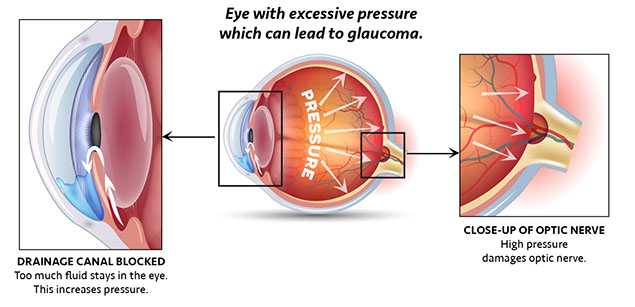SYMPTOM CHECKER
CONDITIONS
Male
Female
Child
Arm, Hand & Shoulder Concerns
Legs & Feet Concerns
Dental & Mouth Concerns
Ear & Nose
Eye Conditions
Head Conditions
Arm, Hand & Shoulder Concerns
Legs & Feet Concerns
Front
Back
Arm, Hand & Shoulder Concerns
Dental & Mouth Concerns
Ear & Nose
Eye Conditions
Head Conditions
Arm, Hand & Shoulder Concerns
Dental & Mouth Concerns
Ear & Nose
Eye Conditions
Head Conditions
Front
Back
Arm, Hand & Shoulder Concerns
Neck Links
Head & Neck Concerns
Arm, Hand & Shoulder Concerns
Neck Links
Head & Neck Concerns
Front
Back
Online Clinic
Wise Healthcare
Under pressure: What to know about glaucoma
Print on Demand
Glaucoma is a leading cause of blindness for people over 60, so it’s important to know what you can do about it.
Glaucoma happens when too much fluid builds up in the eye. This extra fluid causes pressure that damages the optic nerve. This damage cannot be undone once it happens. It can lead to loss of all or part of your vision. But, glaucoma can be managed and the damage to vision can be decreased with proper medical care.
People at highest risk for glaucoma
Anyone can get glaucoma. But certain groups of people may be more likely to get it, including:
• People with a family history of glaucoma
• African Americans over age 40
• Anyone over age 60, but Mexican Americans are especially at risk
• People who have high eye pressure, thin corneas or optic nerve problems
• People with high blood pressure that’s not well controlled
Signs and symptoms
Glaucoma often doesn’t have early signs and symptoms until damage has already been done. That’s why getting regular eye exams is so important. For many people, the first sign of glaucoma is loss of their peripheral (side) vision.
Don’t assume you don’t have glaucoma because your eyes “feel fine.” Many people develop glaucoma without any symptoms.

What can you do about glaucoma?
Glaucoma has no cure, but there are things you can do to slow it down and save your vision:
• If you have glaucoma, take your medicines every day. Ask your eye doctor how often you need to be seen, and stick to your appointments.
• Get a complete eye exam at least every 2 years or as often as recommended. This includes a dilated eye exam.
• Even if you don’t have glaucoma, ask your eye doctor about your risk. This includes telling your doctor about any family history of glaucoma.
People with certain risk factors for glaucoma may be given special eye drops. These drops can lower the risk of getting glaucoma but they must be used regularly to be effective.
If you are diagnosed with glaucoma, you and your doctor will discuss what treatment is best for you. It may depend on what type of glaucoma you have and how severe it is. Treatments may include:
• Eye drops that lower pressure in the eye
• Surgery done with a laser that helps the eye drain fluid better
• Traditional surgery that may include placing a new drainage tube in the eye
Save your sight – see your eye doctor to get checked for glaucoma!
Sources: American Academy of Ophthalmology, National Eye Institute
This website is not meant to substitute for expert medical advice or treatment. Follow your doctor’s or health care provider’s advice if it differs from what is given in this guide.
The American Institute for Preventive Medicine (AIPM) is not responsible for the availability or content of external sites, nor does AIPM endorse them. Also, it is the responsibility of the user to examine the copyright and licensing restrictions of external pages and to secure all necessary permission.
The content on this website is proprietary. You may not modify, copy, reproduce, republish, upload, post, transmit, or distribute, in any manner, the material on the website without the written permission of AIPM.
2021 © American Institute for Preventive Medicine - All Rights Reserved. Disclaimer | www.HealthyLife.com
















































